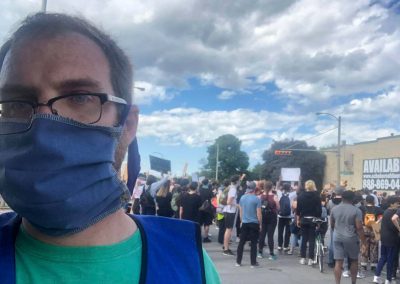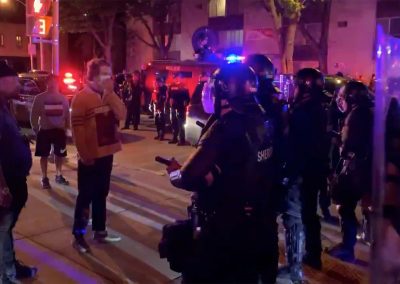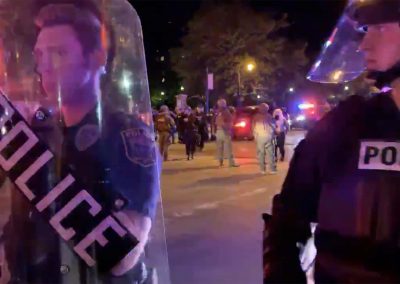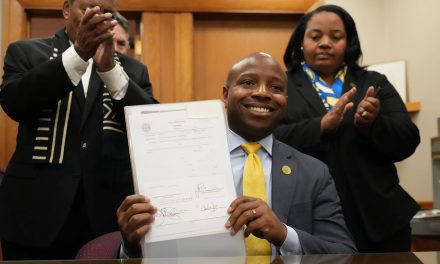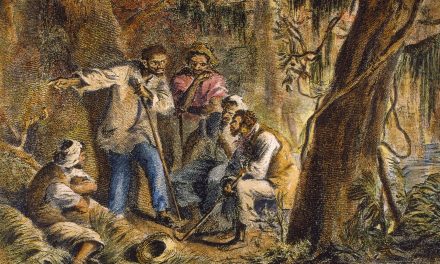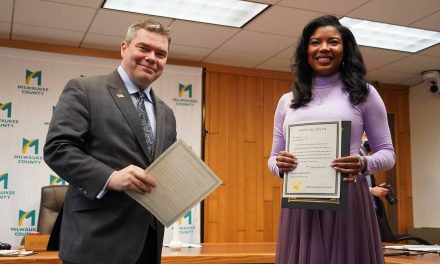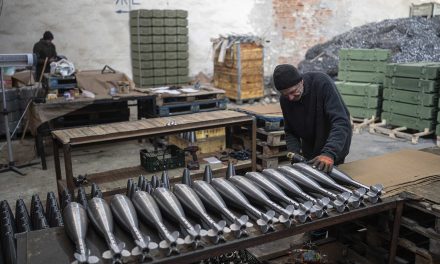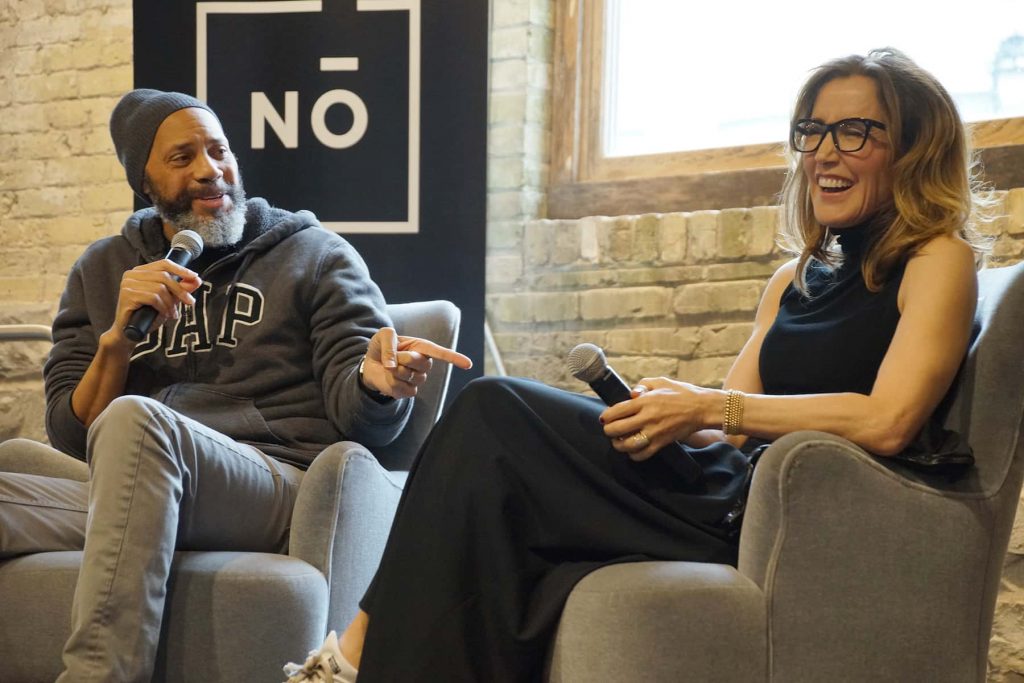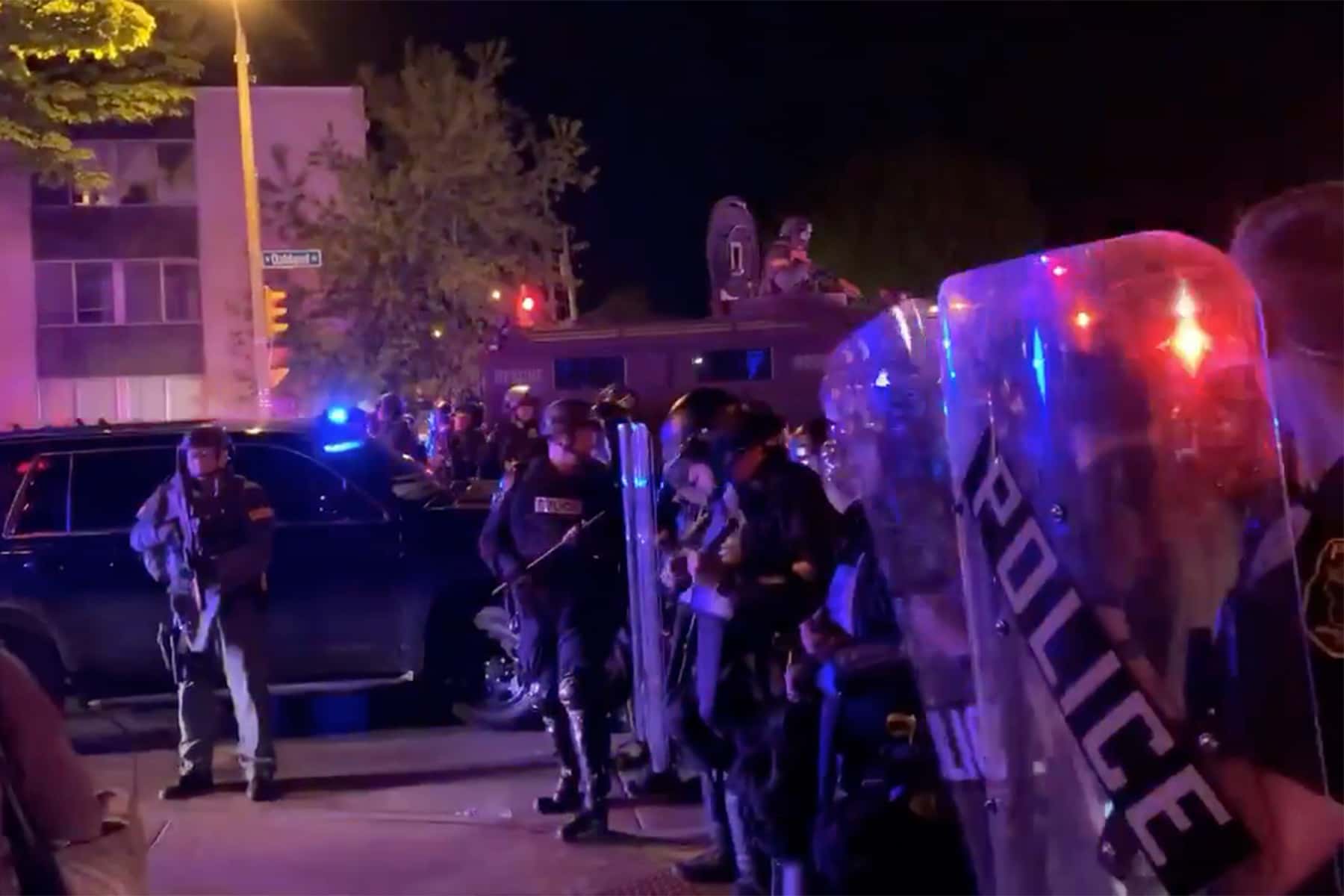
Officers of the Milwaukee Police Department arrested Milwaukee County Supervisor Ryan Clancy following a peaceful protest in Shorewood on Sunday, May 31, after the city’s 9:00 p.m. curfew. Supervisor Clancy was filming an altercation provoked by police on his phone when he was blindsided by an officer and tackled to the ground.
As an elected official attending the peaceful march, Supervisor Clancy was exempt from the May 31 proclamation by Mayor Tom Barrett, which was issued to maintain safety in the City of Milwaukee in the aftermath of the death of George Floyd by a white Minneapolis police officer. Similar to how members the ACLU of Wisconsin are present at protests to be legal observers, Clancy attended in his capacity as a County Supervisor to be a resource for his constituents.
The following credentialed personnel, working in their official capacity, are exempt from this order: government, emergency services, utility services, medical providers, social services providers and press. Persons experiencing homelessness, fleeing dangerous domestic situations or seeking medical care are also exempt from this order.
Supervisor Clancy’s arrest was first reported by Urban Milwaukee’s Jeramey Jannene, along with a video of police zip tying his hands. Multiple eyewitnesses on the scene said that police refused to check his identification and arrested him anyway. Across social media, many participants from the protest also shared their frustration that law enforcement was using the curfew to make unlawful arrests.
“My friend Ryan Clancy was arrested while filming a woman being thrown to the ground by MPD last night. Ryan is a county Supervisor for Milwaukee, as well. This is so wrong on many levels.” – Kristen Keyser
“An officer told me they weren’t prepared because their schedule was made lat week before the curfew was in place. And they say ‘they can’t’ just let people go, even though we reminded them that yes, they actually can.” – Michele Hilbert
“It’s surreal to watch our tax dollars go to militarizing our local police force who then uses that equipment to bully, threaten, and harm unarmed citizens attempting to protest legally. Maybe the right winger are onto something by marching with AR-15 rifles.” – James Alevizo
Supervisor Clancy was arrested before 11:00 p.m. and released around 3:00 a.m. He called the actions on Sunday night unwarranted and accused the police of needlessly escalating the situation that put the public in danger. As a result of the incident, he felt that it was duty and responsibility as an elected official to reign in future abuses and defund law enforcement, shifting that budget money to infrastructure needed to help the community – like public health and social services.
“What I witnessed was not officers giving orders, and then waiting for those orders to be complied with. It was officers escalating a situation by literally grabbing people out of the crowd, throwing them on the pavement, and making arrests,” said Supervisor Clancy. “I only saw law enforcement running in and grabbing people who were just standing there, and that’s a terrifying thing to see, especially given that the larger protest that these are in the context of were police brutality,”
By curfew time, there appeared to be two different protests occurring miles apart but law enforcement conflated the situation. A large group of people walking in a residential area on the eastside was not smashing business windows or spraying graffiti, yet the police arrived in force and with an armored vehicle.
“What was a small, peaceful, unremarkable gathering of people on the border of Shorewood and the City of Milwaukee was very suddenly surrounded by scores of law enforcement, from five different jurisdictions, in militarized vehicles and full riot gear,” added Supervisor Clancy. “No arrest at that scene was for a violent act, nor even for the sort of property crime that some media outlets are focusing on more than the loss of life at the core of this protest. No crimes were stopped. Nobody was protected. Every arrest at that scene was primarily for a curfew violation – for merely existing in a space which many of us were forced into by a line of police in riot gear. And those arrests were brutal. The Milwaukee Police Department did not issue orders and then arrest people for failing to comply, but simply grabbed and tackled people, throwing them to the ground. I was among them.”
Sachin Chheda, a resident of the area and partner of a Wisconsin-based public strategies firm, filmed a livestream to his Facebook page during and after the protest. His reports documented the situation, and he shared his observations.
“There’s a lot of anger at the police. The attitude of the police was very confrontational. They’re not really trying to de-escalate. They’re just trying to direct people the way they want to direct people. Very unfriendly in their interactions. They’re not interested in understanding why people are angry. And that’s making people more angry, and act in a more unsafe manner,” said Chheda in his videostream. “I’m going to put that 100% on the police in the way that they’re behaving, and the way that they’re engaging with people, which has been very negative. It’s really unfortunate that the police aren’t interacting with people with any sort of empathy or understanding.”
Chheda said the group of protestors had been completely peaceful. He was disappointed that there was not any police engagement like in Green Bay, where the Chief of Police spoke with the crowd.
“Nobody was asked to disperse nicely. And then all of a sudden a wall of police vehicles – including armored vehicles – came west down the hill on Locust, shooting tear gas canisters into the crowd,” added Chheda. “We saw at least one ambulance followed by a car so we know somebody was injured on Locust. You had the crowd running – for all you know – to safety. It made a situation that was not particularly unsafe, much more unsafe.”
On social media, Chheda shared more details from the experience, his thoughts about how the police managed the situation, and a call to action for preventing a repeat in the future.
- I was a participant last night, joining in when the march went past my house. Three of my kids marched as well. I’m not an organizer of these protests, and I encourage you to lift up the young and fresh leadership in our community doing the hard work of organizing.
- The state murder of Black people must be stopped. We must address broader issues of systemic racism, but let’s start with ending the 400-year-plus era of authorities murdering Black people on this soil.
- What I saw from the police was the tip of the iceberg. The video from County Supervisor Ryan Clancy was even clearer. A woman yelling at the cops, but not in any way posing a threat, taken roughly to the ground to be arrested, and then they arrest a polite and calm elected official bearing witness. The way they tear-gassed a peaceful crowd was dangerous and provocative.
- This is about training and culture. We need to change how we train our police, and we need to change the culture of police. They need to stop glorifying military tactics and equipment and stop the adversarial, occupying posture.
- The five police departments from the northshore banding together in a massive show of force to make sure the multi-racial, young, and peaceful marchers didn’t even dare to enter Shorewood was one of the most racist things I’ve ever seen and I hope the progressive leadership of Shorewood stands up to say their policies must change too.
- I hope my friends, many of whom I’ve worked hard to help elect, on the Milwaukee Common Council, and the Mayor I’ve long supported, move with strength and purpose to change the attitude and posture of the police the people of this community fund. We expect better and we expect better right now.
What happened in Milwaukee echoed in cities across the nation. The demonstrators were Americans. The protestors in Shorewood were neighbors, co-workers, friends, and fellow tax payers. Yet the country’s leadership continues calling for law enforcement to show more brutality and punishment against our own people.
In a May 31 Tweet, President Trump wrote: “The United States of America will be designating ANTIFA as a Terrorist Organization.”
Antifa, short for anti-fascists, describes a broad group of people with political beliefs that lean toward the left, but do not conform into a single political platform except to oppose fascism. With Trump’s declaration, he publicly admited to embracing fascism by condemning anyone against it. In practical terms, he called every WWII veteran who fought against Nazi Germany a terrorist.
A day later, Trump reportedly criticized and bullied state governors in a conference call on June 1 for failing to do enough to “dominate” the tens of thousands of people who have taken to the streets protesting the police killing of George Floyd.
“You have to dominate, if you don’t dominate you’re wasting your time. They’re going to run over you, you’re going to look like a bunch of jerks. You have to dominate. You’ve got to arrest people, you have to track people, you have to put them in jail for 10 years and you’ll never see this stuff again. You know when other country’s watch this, they’re watching this, the next day wow, they’re really a push over. And we can’t be a push over. And we have all the resources — it’s not like we don’t have the resources. So, I don’t know what you’re doing. It’s a movement, if you don’t put it down it will get worse and worse…. The only time its successful is when you’re weak and most of you are weak,” said Trump in an audio recording obtained by CBS News.
Trump said he would mobilize “all available federal resources, civilian, and military” to clamp down on protests across the country, declaring himself the “president of law and order” and putting the nation under Martial law. Trump would need to invoke the Insurrection Act that allows U.S. troops to be deployed domestically without state governors requesting them.
Supervisor Clancy said that a curfew, and the disproportionate application of brutal force – in the midst of a protest against brutal force – was not the way forward. The footage from his mobile phone of the incident with police, along with the livestream videos from Chheda are included here.
“When Colin Kaepernick knelt, they said, ‘this is not the right way to protest.’ When MLK marched in Selma, they said, ‘this is not the right way to protest.’ When people marched in the streets of South Africa during Apartheid, they said, ‘this is not the right way to protest.’ There is no right way to protest because that’s what a protest is. It can’t be considered ‘Right’ by the system that it’s protesting.” – Trevor Noah
© Video
Ryan Clancy and Sachin Chheda

